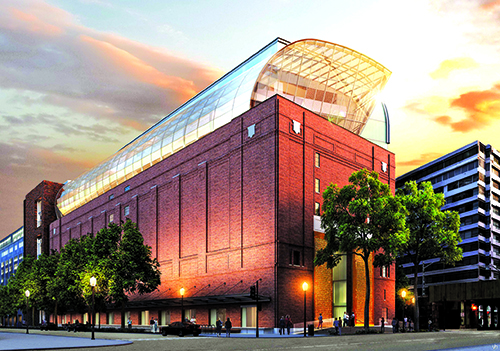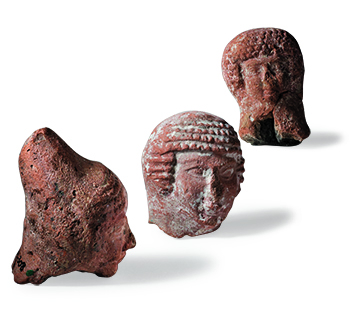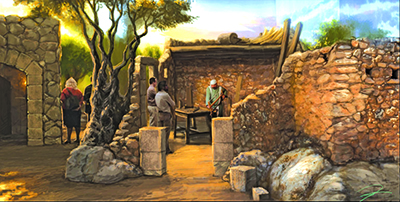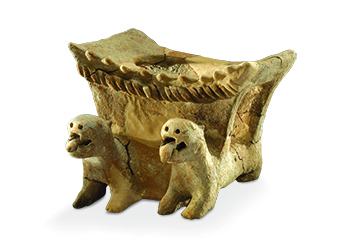Arts
Exhibit
A Museum of Biblical Proportions

It took centuries for the Bible to evolve into a global best seller. The world’s most ambitious museum dedicated to the massive text required considerably less time to create.
Steve Green, an Oklahoma City-based evangelical Christian and president of the Hobby Lobby retail chain, began collecting biblical artifacts in 2009. Less than a decade later, his family’s collection forms the core of the Museum of the Bible, a 430,000-square-foot, technologically immersive institution scheduled to open in November off the National Mall in Washington, D.C.
Despite the project’s immense scale—at a cost of $500 million—museum president Cary Summers said its mission is simple: “We’re just letting the Bible stand on its own two feet and tell its story.”
Summers, who also developed the open-air Nazareth Village theme park in Israel that recreates Jesus’ first-century world, hopes American Jews will take him at his word. While the museum’s founders are evangelical Christians, Summers said a third of its consultants are Jewish; its restaurant will serve kosher meals; and it has a long-term partnership with the Israel Antiquities Authority.
All of which is part of a concerted effort to reach out to what museum officials acknowledge may be a skeptical crowd. They know some Jews and others may be wary of a privately owned Bible museum backed by a company with longtime support for evangelical causes, or uncomfortable with Christians curating the story of biblical Israel in the heart of America’s capital.
Some may recall that Hobby Lobby was the target of a 2017 lawsuit by the United States Department of Justice, which found that the company had purchased thousands of illegally smuggled antiquities. Summers and his colleagues claim the museum’s 40,000 artifacts are all legitimately sourced and separate from those in the lawsuit. Hobby Lobby may be best known, however, for the controversial 2014 Supreme Court ruling exempting the company, along with others, on religious grounds from the Affordable Care Act’s employer-subsidized contraception mandate.
“This museum isn’t about my family or me,” Green, who chairs the museum board, reflected in an email interview. “We want this museum to be for all people to come and engage with the Bible and learn about its history, narrative and impact.”

Amanda Weiss, director of the Bible Lands Museum in Jerusalem, which lent its “David and Goliath” archaeology show for the new museum’s opening, is a supporter. The new institution, she said, “is a game changer for all of us.”
Both investment and ambition are obvious from the moment visitors walk in the massive doorway, which is flanked by 40-foot-high bronze panels depicting the first page of Genesis from an early edition of the Gutenberg Bible—a nod to the book’s status as the first printed in moveable type.
Inside, a 140-foot-long LED screen illuminates biblical scenes across the soaring lobby ceiling. Entrance is free, and each patron gets a “digital docent,” a handheld device—created with an Israeli firm, Compedia—that personalizes the experience. Visitors can tailor a tour to specific interests, like Jewish artifacts or child-friendly displays. Or they can use the device to virtually interact with exhibitions.
But it’s not all virtual. “This is a working museum,” said executive director Tony Zeiss. “We’ll have scholars working on artifacts right here, adding to the body of knowledge of the Bible every week.”
One example is Rabbi Eliezer Adam of the Machon Melechet Shamayim school of scribal arts in Jerusalem. He is spending a year as the museum’s scribe-in-residence—writing a Torah surrounded by over 600 decommissioned scrolls from various centuries. Armed with paper and ink, Adam’s role is to teach children to write Hebrew letters, “to connect the amount of care and labor that goes into one scroll, and translate that into all the scrolls used in congregations around the world,” explained Seth Pollinger, the museum’s director of content.
Jewish elements are prominent throughout the eight-story museum. Core exhibitions focus on the Hebrew Bible’s history and biblical narrative as well as its impact on everything from fashion to the American Revolution.
The first century CE is the subject of both a permanent gallery, “The World of Jesus of Nazareth,” which features live “interpreters” in period costumes, and a planned 2018 installation from the Hebrew University of Jerusalem. The gallery is a reminder that despite the museum’s multifaith programming, Christianity is the point of reference not only for most of the institution’s founders and scholars, but also for most Americans.

“The Bible treated as an object in a museum is such a Protestant conceptualization,” opined Professor Richard Hecht, a Judaic studies and religious history scholar at the University of California, Santa Barbara, who said bias is inherent in any presentation of religion or history. “In a Jewish museum, you’d have manuscripts, but you wouldn’t have a museum of the Bible.”
At the same time, Hecht observed that religious history is a growing field in America, despite what the Pew Research Center measures as slight but consistent declines in American religiosity. Witness not only the Museum of the Bible, but also the recent installation of a religion curator—novelist Peter Manseau, a 2009 National Jewish Book Award winner—at the nearby Smithsonian’s National Museum of American History.
Some Jewish scholars defend the Museum of the Bible’s objectivity and welcome the opportunity to explore Jewish as well as Christian biblical history. “The era of religious antagonism is over,” said Professor Leonard Greenspoon, the Klutznick Chair in Jewish Civilization in the department of theology at a Jesuit institution, Creighton University in Omaha, Neb.
Greenspoon acknowledged his own initial concern over the museum’s evangelical connection. But as a consultant, Greenspoon said, he has been impressed with the “absolute wall” between the museum’s backers—not only the Greens, but also their 50,000 fellow donors, including the institution’s largest financial backer, the National Christian Foundation—and the scholars shaping its content, who “have high regard for the truth and no religious agenda,” he said.

That approach is essential for mainstream respect, noted Israel Finkelstein, the Jacob M. Alkow Professor of the Archaeology of Israel in the Bronze and Iron Ages at Tel Aviv University. But it’s just as important, Finkelstein added, to provide museum-goers with the context needed to make sense of artifacts like the Dead Sea Scrolls, fragments of which will be on view on the history floor. “Reading the texts critically, attempting to understand the historical, cultural and ideological background,” he explained, is vital.
For her part, the Bible Lands Museum’s Weiss is impressed by the museum team’s passion for Israel. She described the institution as an opportunity for Jews to learn about “the roots of our civilization and our culture today.
“As Jews, it is what ties us together as a people,” Weiss said of the Bible. Given that it is referenced by everyone from George Washington to Bob Marley, the Bible “is almost a guidebook to humanity.”
Hilary Danailova writes about travel, culture, politics and lifestyle for numerous publications.










 Facebook
Facebook Instagram
Instagram Twitter
Twitter
Leave a Reply